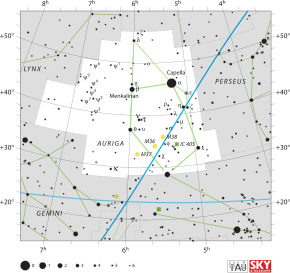Auriga
| Constellation | |
 | |
| Abbreviation | Aur |
|---|---|
| Genitive | Aurigae |
| Right ascension | 6 |
| Declination | +40 |
| Area | 657 sq. deg. (21st) |
| Main stars | 5, 8 |
| Bayer/Flamsteed stars | 58 |
| Stars with planets | 3 |
| Stars brighter than 3.00m | 4 |
| Stars within 10.00 pc (32.62 ly) | 3 |
| Brightest star | Capella (α Aur) (0.08m) |
| Messier objects | 3 |
| Meteor showers | Alpha Aurigids Delta Aurigids |
| Bordering constellations | Camelopardalis Perseus Taurus Gemini Lynx |
| Visible at latitudes between +90° and −40°. Best visible at 21:00 (9 p.m.) during the month of February. | |
Auriga (IPA: [ɔˈɹaɪgə], Template:Lang-la) is a northern constellation. It was one of the 48 constellations listed by Ptolemy, and counts as one of the 88 modern constellations. Its brightest star is Capella, which is associated with the mythological she-goat Amalthea. The three stars ε Aurigae, ζ Aurigae and η Aurigae are called Haedi (the Kids).
Notable features
ε Aurigae and ζ Aurigae are peculiar binary stars. The orbital period of ε Aurigae is approximately 27 years, with an eclipse duration of about 18 months. The visible companion is a yellowish F-class supergiant. The type of the other star is not known. ζ Aurigae has a period of 970 days, the primary is a K-class supergiant and the secondary is a B-class main sequence star. Both these systems present a rare stage of binary evolution, as the components are in a short and active evolutionary stage.
Notable deep sky objects
Auriga has many open clusters and other objects because the Milky Way runs through it. The three brightest open clusters are M36, M37 and M38, all of which are visible in binoculars or a small telescope in suburban skies. A larger telescope resolves individual stars. The clusters are about 4100, 4400, and 4200 light years distant, respectively. Their apparent visual magnitudes are 6.3, 6.2, and 7.4, respectively.
Three other open clusters are NGC 2281, lying close to ψ7 Aurigae, NGC 1664, which is close to ε Aurigae, and IC 410 (or NGC 1893), a cluster with nebulosity next to IC 405, the Flaming Star Nebula, found a few degrees to the right of M38. AE Aurigae, a runaway star, is a bright variable star currently located within the Flaming Star Nebula.
This section needs expansion. You can help by adding to it. |
.
Before the classical era, it was also identified as a chariot and its driver, which, considering its fainter stars visible to the naked eye, it resembles. However, the driver was considered to be a shepherd, usually one which had flung a goat over its left shoulder (due to the resemblance of that area to a lump), and had its kids (two bright stars) nearby.
Together with the area of the sky that is deserted (now considered as the new and extremely faint constellations Camelopardalis and Lynx), and the other features of the area in the Zodiac sign of Gemini (i.e. the Milky Way, and the constellations Gemini, Orion, and Canis Major), this may be the origin of the myth of the cattle of Geryon, which forms one of The Twelve Labours of Heracles.
Graphic visualization
The stars of the constellation Auriga can be connected in an alternative way, which graphically shows the charioteer's head wearing a pointy cap and facing towards Perseus.

Stars α Aur (Capella), β Aur, θ Aur, ι Aur, and ε Aur form the charioteer's head: with α Aur being of magnitude zero, β Aur being of magnitude two, and the rest of the stars being of magnitude three. Star α Aur may be taken to represent the charioteer's eye, whereas star ι Aur represents the charioteer's chin.
Stars β Aur, δ Aur, and α Aur form the charioteer's pointy cap, with δ Aur being the top of the cap.
Finally, the stars α Aur, ε Aur, ζ Aur, and η Aur form the charioteer's nose: η Aur being of the third magnitude.
See also
References
- H. A. Rey, The Stars — A New Way To See Them. Enlarged World-Wide Edition. Houghton Mifflin, Boston, 1997. ISBN 0-395-24830-2.
